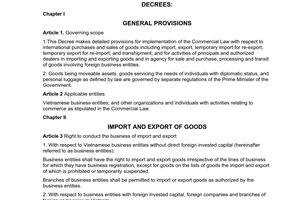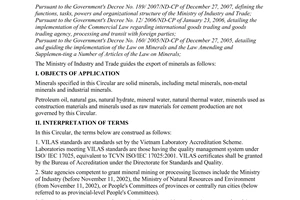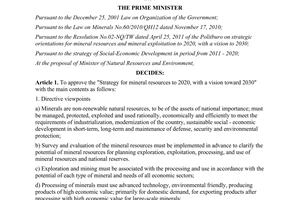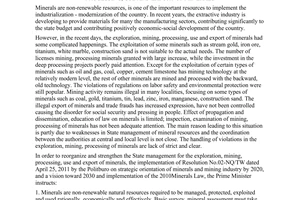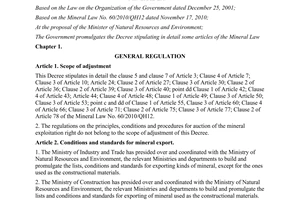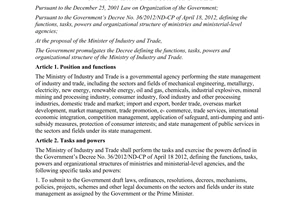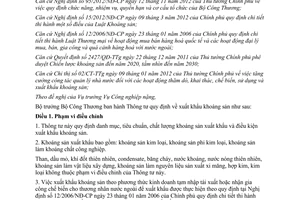Nội dung toàn văn Circular No. 41/2012/TT-BCT on the export of minerals
|
THE MINISTRY
OF INDUSTRY AND TRADE |
SOCIALIST
REPUBLIC OF VIETNAM |
|
No. 41/2012/TT-BCT |
Hanoi, December 24th 2012 |
CIRCULAR
ON THE EXPORT OF MINERALS
Pursuant to the Decree No. 95/2012/NĐ-CP dated November 12th 2012 of the Prime Minister, defining the functions, tasks, powers and organizational structure of the Ministry of Industry and Trade;
Pursuant to the Government's Decree No. 15/2012/NĐ-CP dated March 09th 2012, detailing the implementation of a number of articles of the Law on Mineral;
Pursuant to the Government's Decree No. 12/2006/NĐ-CP dated January 23rd 2006, detailing the implementation of the Law on Trade applicable to international goods trade and the activities of agents, trading, processing, and transiting of goods with foreign partners;
Pursuant to the Prime Minister’s Decision No. 2427/QĐ-TTg dated December 22nd 2011, approving the Mineral strategy by 2020, and the orientation towards 2030;
Pursuant to the Prime Minister’s Directive No. 02/CT-TTg dated January 09th 2012 on the enhancement of the State management of the exploration, extraction, processing, use, and export of minerals;
At the proposal of the Director of the Department of Heavy Industry,
The Minister of Industry and Trade issues a Circular on the export of minerals:
Article 1. Scope of regulation
1. This Circular provides the list, quality standards of exported minerals and the conditions for exporting minerals.
2. The exported minerals include: metallic minerals, non-metallic minerals, industrial minerals.
Coal, petroleum, natural inflammable gases, condensate, methane hydrate, mineral water, natural hot water, mineral as building materials, minerals for producing cement, alloy, and metal that are not regulated by this Circular.
3. The export of minerals in the form of temporary import for re-export or export processing must comply with the Government's Decree No. 12/2006/NĐ-CP dated January 23rd 2006, detailing the implementation of the Law on Trade applicable to international goods trade and the activities of agents, trading, processing, and transiting of goods with foreign partners. When a new Decree supersedes the Decree No. 12/2006/NĐ-CP the export of minerals mentioned in this Clause shall comply with the new Decree.
Article 2. Subjects of application
This Circular is applicable to the State management agencies and the enterprises related to the export of minerals.
Article 3. Interpretation of terms
In the Circular, the terms below are construed as follows:
1. VILAS standards: are the standards of the Vietnam Laboratory Accreditation Scheme.
2. Competent State agencies are the central State management agencies (the Ministries), and People’s Committees of central-affiliated cities and provinces (hereinafter referred to as provincial People’s Committees).
3. Mineral processing: is the process of separating or combining the mechanical-physical-chemical to change the properties of raw minerals in order to create one or multiple products in the form of: refined ore, metal, alloy, chemical compounds, and industrial minerals of which the specifications and properties are suitable for the use purposes, the use value and commercial value are high than the raw minerals.
Article 4. Conditions for exporting minerals
1. Only enterprises are allowed to export minerals. The mineral exporters are the enterprises established and operated in accordance with the Law on Enterprises, satisfy all requirements prescribed in the Law on Commerce applicable to the export, import, processing, and agents of goods with foreign partners.
2. Minerals are allow to be exported when all of the following conditions are satisfied:
a) The minerals are processed and in the list in the Annex enclosed with this Circular.
b) The minerals satisfy the quality standards that are not lower than that provided in the Annex enclosed with this Circular.
c) The origins of minerals are legal, in particular:
- The minerals are extracted from the mines that have unexpired Licenses for extraction or the License for exploitation issued by competent State agencies; or
- The minerals are legally imported; or
- The minerals are confiscated and liquidated by competent State agencies.
The imported minerals (for re-export or export processing) are considered legal when the Declaration of imported minerals certified by the checkpoint customs is presented (the authenticated copy).
For confisticated and liquidated minerals, the following papers are required: the sale invoices of the confiscated and expropriated assets, the delivery bill, the Record on the handover of violating assets that are confiscated and put up for auction (the authenticated copy).
Article 5. The procedure for exporting minerals
1. When following the procedure for exporting minerals, the following papers must be presented apart from the requirements from the Customs:
- The sample test result for certifying the conformity with the quality standards of the exported consignment, issued by a laboratory that satisfies the VILAS standards.
- The papers proving the legal origins of the exported minerals, in particular:
a) For the enterprises that extract minerals: the unexpired License for extraction or the License for exploitation.
b) For the enterprises that process minerals: the Certificate of investment in the processing factory and the Mineral sale contract from the enterprise that extract minerals legally, or the valid papers about the import of minerals (when the enterprise uses materials being imported minerals as prescribed in Point c Clause 2 Article 4).
c) For commercial enterprises that export and import minerals: the mineral sale contract enclosed with the copy of the VAT invoice or the entrusted mineral import contract signed with the enterprises prescribed in Section (a) and (b) of this Clause, or the valid papers about the purchase of minerals being confiscated and liquidated by competent State agencies (prescribed in Point c Clause 2 Section 4).
2. During the customs clearance procedure, if the checkpoint customs suspects that the consignment of exported minerals does not satisfy the quality standards prescribed in this Circular, the customs may still grant the customs clearance, then concurrently make records and take samples for testing again. The test is carried out by a laboratory that satisfies the VILAS standards. If the test result confirms the suspicion, the exporter shall be penalized as prescribed by current regulations and incur the cost of testing. If the test result show that the consignment satisfies the prescribed quality standards, the customs shall incur the cost of testing.
Article 6. Special cases
1. In the following cases, if the enterprise wishes to export minerals, it shall send report to the provincial People’s Committee where the minerals are extracted or processed for. Then the People’s Committee shall inspect, certify, and send written request to the Ministry of Industry and Trade for consideration and settlement:
- The minerals are in the list of minerals eligible for export, processed, but do not satisfy the quality standards due to objective reasons (such as the geological characteristics of the mine, the minerals are by-products collected during the processing of the primary minerals, or the tailings of which the content is not able to be increased, etc.)
- The remaining minerals of the mines of which the Licenses for extraction are expired.
- The minerals not in the list of minerals eligible for export, but are not demanded or not completely consumed by the domestic market.
- The exported minerals for reciprocating with the import of goods necessary for the domestic production.
Based on the written request from the provincial People’s Committee, the Ministry of Industry and Trade shall preside and cooperate with relevant agencies in considering and resolving each case.
Article 7. The report on the export of minerals
1. The report on the export of minerals includes:
- The types, amount, and turnover of exported minerals, the origins of exported minerals.
- The compliance with the regulations on the export of minerals.
2. There are two kinds of mineral export reports:
- The reports made by mineral exporters shall be made periodically. The reporting period shall by decided by the provincial People’s Committees depending on the local management requirements. The reports shall be sent to the Service of Industry and Trade and the Service of Natural Resources and Environment where the minerals are exported.
- The overall reports annually made by the provincial People’s Committees (or functional agencies assigned by the provincial People’s Committees) where the minerals are exported) and sent to the Ministry of Industry and Trade before January 15th of the next year (Form 01).
3. The mineral exporters are responsible for the accuracy of the reports.
4. The mineral exporters shall make irregular reports on the export of minerals at the request of the competent State agency in order to serve their management.
Article 8. The responsibility for management
1. The Department of Heavy Industry (the Ministry of Industry and Trade) shall presided and cooperate with the relevant Ministries and local authorities in periodically inspecting the compliance with the regulations on export of minerals prescribed in this Circular and relevant laws.
2. Depending on the development of the extraction, processing, domestic consumption, and export of minerals, the Department of Heavy Industry shall send reports to the Ministry of Industry and Trade for amending and supplementing this Circular.
Article 9. Effects
This Circular takes effect on February 04th 2013, and supersedes the Circular No. 08/2008/TT-BCT dated June 18th 2008 of the Ministry of Industry and Trade, guiding the export of minerals.
Article 10. Implementation organization
1. The valid mineral export contracts (according to the Circular No. 08/2008/TT-BCT dated June 18th 2008 of the Ministry of Industry and Trade) that were signed before this Circular takes effect and do not contradict the Prime Minister’s Directive No. 02/CT-TTg dated January 09th 2012 and this Circular, are still effective.
2. The exports of some minerals being legally extracted or in stock in 2012 (for resolving difficulties of enterprise) shall comply with the directions from the Prime Minister, this Circular, and the guidance from the Ministry of Industry and Trade.
3. The Ministry of Industry and Trade are entitled to request the suspension of the mineral export if the exporter is found violating this Circular.
4. The State management agencies and the enterprises related to the export of minerals are responsible for the implementation of this Circular. Organizations and individuals are recommended to send feedbacks on the difficulties arising during the course of implementation to the Ministry of Industry and Trade for consideration and settlement./.
|
|
FOR THE
MINISTER |
ANNEX
THE LIST AND
QUALITY STANDARDS OF EXPORTED MINERALS
(Enclosed with the Circular No. 41/2012/TT-BCT dated December 24th
of the Ministry of Industry and Trade)
|
No. |
List of exported minerals |
Quality standards |
Notes |
|
1 |
Products from titanium ore |
|
|
|
1.1. Zirconia powder |
ZrO2 ≥ 65%, particle ≤ 75 µm |
|
|
|
1.2. reverted ilmenite |
TiO2 ≥ 56%, FeO ≤ 9%, Fe ≤ 27%. |
|
|
|
1.3. Titanium slag type 1 |
TiO2 ≥ 85%, FeO ≤ 10% |
|
|
|
1.4. Titanium slag type 2 |
85%>TiO2≥70%, FeO ≤ 10% |
|
|
|
1.5. Refined rutile ore 1.6. Artificial rutile/synthetic rutile 1.7. Refined monazite ore |
TiO2 ≥ 83% TiO2 ≥ 83% REO ≥ 57% |
|
|
|
2 |
Products from bauxite ore 2.1. Alumina |
Al2O3 ≥ 98,5% |
|
|
2.2. Aluminium hydroxide Al(OH)3 |
Al2O3 ≥ 64% |
|
|
|
3 |
Refined copper ore (Nui Phao Mineral Extraction and Processing LLC) |
Cu≥20% |
Export until the end of 2015 |
|
4 |
Refined wolfram ore (Nui Phao Mineral Extraction and Processing LLC) |
WO3≥ 55% |
Export until the end of 2015 |
|
5 |
Refined bismuth ore |
Bi ≥ 70% |
|
|
6 |
Refined nickel ore (Ban Phuc Nikel Mine LLC) |
Ni ≥ 9,5% |
|
|
7 |
Rare-earth oxides |
TREO ≥ 99% |
|
|
8 |
Refined fluoride ore |
CaF2 ≥ 90% |
|
|
9 |
White marber 9.1. Powder |
- Particle < 1mm; whiteness ≥ 90% |
|
|
9.2. Lump |
- Particle size: 1mm – 400mm; whiteness ≥ 85% |
Export until the end of 2015 |
|
|
10 |
Baryte powder |
BaSO4≥90%, particle <1mm |
|
------------------------------------------------------------------------------------------------------
This translation is made by LawSoft,
for reference only. LawSoft
is protected by copyright under clause 2, article 14 of the Law on Intellectual Property. LawSoft
always welcome your comments


